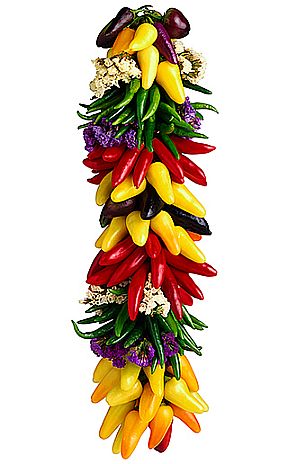Count us here at Banderas News among those who are passionate about chili peppers.
These fiery fruits are beloved around the world for their ability to intensify nearly any cuisine. They are one of the most important and widely grown spice crops in the world, so it's hard to imagine that their reach was once limited to the early farmers in what is now southeastern Mexico.
Now we know just a little bit more about where they came from, thanks to an international team of researchers led by University of California, Davis plant scientist Paul Gepts.
To determine a crop's origins, scientists typically use plants' genetic makeup in geographic areas with the most diversity, and where they have found archaeological remains. They also model the areas most environmentally suitable to the plants and their ancestors. Along with these more traditional ways of figuring out how and where plants are domesticated Gepts' team added paleobio-linguistics to the mix — namely, studying ancient languages for the earliest words that mean chili pepper.
While the genetic evidence had pointed to northeastern Mexico as the domesticated chili pepper's birthplace, the collective evidence from all four lines of study suggest a regional, rather than a geographically specific birthplace for the domesticated chili pepper.
 |
"The central-east region, extending from southern Puebla and northern Oaxaca to southeastern Veracruz, is further south than was previously thought," a UC Davis press release says. "This region is also different from areas of origin that have been suggested for common bean and corn, which were presumably domesticated in western Mexico."
Crop domestication, the process of selectively breeding a wild plant or animal species, has become of ever increasing interest to scientists in recent years.
"Identifying the origin of the chili pepper is not just an academic exercise," says Gepts. "By tracing back the ancestry of any domesticated plant, we can better understand the genetic evolution of that species and the origin of agriculture — a major step in human evolution in different regions of the world. This information, in turn, better equips us to develop sound genetic conservation programs and increases the efficiency of breeding programs, which will be critically important as we work to deal with climate change and provide food for a rapidly increasing global population. The findings also have important implications for understanding nutrition-related diseases, the use of crops for health-related benefits, and crop production and resiliency."
The study, which will appear in the April edition of Proceedings of the National Academy of Sciences, looked at 30 ancestral languages of the region and at the words for 41 different crops, including chili pepper, to determine when it was discussed. And according to the paper, it was discussed a lot.
The researcher's evidence indicates that the first cultivators of the chili pepper inhabited Mexico about 6,500 years ago. These ancient Mexicans used chili pepper in drinks to spice them up. Evidence of this was found in ancient pottery unearthed from archaeological sites in southern regions of the country.
Chili peppers have long attracted creative people who have a yen for thrills and a way with words. The New Yorker's Lauren Collins recently profiled the cutthroat subculture of folks working to grow peppers that burn up the heat chart — the Scoville chili heat chart.
"There is a reason no one makes Christmas lights in the shape of rutabagas," Collins wrote. "Superhots come in the brightest colors and the craziest shapes. Their names, evoking travel and conquest — Armageddon, Borg 9, Naga Morich, Brain Strain — sound as though they were made up by the evil twins of the people who brand body lotions."
Sources: UCDavis.edu/NPR.org


